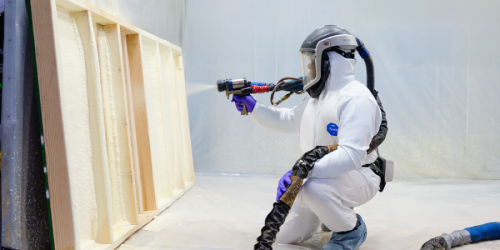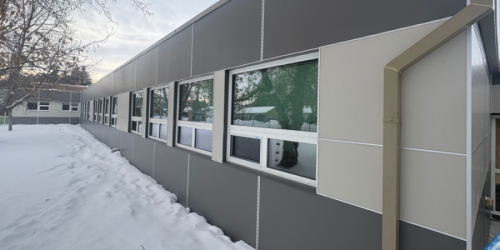Q&A Forums
CC Shrinkage revisited Post New Topic | Post Reply
| Author | Comments |
|---|---|
|
Craig Deim
Posted: Mar 11, 2011 09:30 PM
|
CC Shrinkage revisited
I ve waited a few days to see how the application has reacted. Neither the supplier or the applicator has given me an appraisal on the the situation. This is my own project as a homeowner and doing a 1500 sf additon. I am a retired builder of 29 yrs and have lived thru the energy crisis in the 70s and the interest rate crunch of the 80s. We did all the energy efficient ideas back then and now that I am doing my own, I thought I would use the latest technology. What I didn t realize is how many companies are promoting new and unproven mixes.My unfortunate situation is I have nothing to base the decision to live with it or make the contractor rip it all out and replace. Ninety percent of the application appears to be good but seems to be under extreme tension. I respect all of the ideas offered previous and I checked each one of them. When I cut a cross section from a wall I can hear the relief ( something similar to putting your ear to a bowl of rice Krispies)Is that typical of cutting thru the cells? At the present I have heaters running at 90 plus degrees in the additions to see if stress is a factor. I need to come to a conclusion or tear it out and start over. |
|
Daniel X
Posted: Mar 11, 2011 11:27 PM
|
The tension from shrinkage is NOT normal. Properly installed, quality 2lb. should not be shrinking... |
|
quentin
Posted: Mar 12, 2011 12:56 AM
|
Rice krispies sounds like it may have been off ratio and ISO rich. Is it firm but compresses without any sounds or does ir feel crunchy when you press in to it? |
|
Craig Deim
Posted: Mar 12, 2011 10:32 AM
|
The surface of the foam is solid and is firm when pushed on. When cut into a cross section it seems as some of the lifts are more spongy than the next. It appears by the number and thickness of the lifts they were applied correctly. Less than 1 1/2" per each. There is however tension on the product, enough that when slit vertically with a knife it visably seperates 1/8" immmediately. It will be two weeks since application and now no way to determine the stablity of the job, I am trending toward a removal and replacement. Thank you for your help. |
|
jimcoler
I have over 10 years of experience specifying and installing open and closed cell spray foam. I've sold my business but I'm still selling for the new owners and consulting on large and custom specific jobs. I've expanded my knowledge into t Posted: Mar 12, 2011 03:46 PM
|
This is one of the problems with closed cell and why we don't recommend it for wood built structures. Wood is open cell and WILL expand and contract with heat and moisture. Even good instaled closed cell foam can apply some tension on the walls due to it contracting after cooling. So, I would suggest cutting into each wall cavity and spraying it again at a minimum but otherwise pull it out and use open cell foam. |
|
Posted: Mar 12, 2011 08:06 PM
|
we??? what a bunch of tripe!! are you friggin serious jim??? |
|
Daniel X
Posted: Mar 12, 2011 11:26 PM
|
I can't believe what I just read. Jim you must be quite the salesman. The thickness of the lift is one thing, but the time allowed between lifts is another huge factor. For the record up here in Canada we spray 2lb. into wood structures all day long without these shrinkage problems. Edit: According to Coler.com (Jim's site), he only sprays 1/2lb. crap, so of course he will spread lies to help his cause... |
|
mason
Posted: Mar 13, 2011 09:19 AM
|
As mentioned previously I have been called in to about a dozen foam jobs similar to yours. If the foam appears OK but there is tension, you can relieve the tension by cutting a line in the foam. Wait a week, then V groove the foam back a couple of inches and re spray. I have found this to work very well in instances where the foam has shrunk from the studs. For all of you foam contractors, the density of the foam can be important. The slightly lower density of closed cell foam will have less dimensional stability than the higher density. Try going to a nominal 2lb over a 1.5 to 1.7 lb foam. Also, check the humid aging measurement of the foam. The less volume change the better. Have to agree with dl123, we have been using closed cell foam for more than 45 years on wood framed structures. It is the rare case where shrinkage occurs and though some foam systems have greater dimensional stability than others, I have yet to see a 2 lb sprayfoam that could not be sprayed without shrinkage if you use the correct spray technique. |
|
SprayFoamSupply.com
Posted: Mar 13, 2011 10:27 AM
|
Jim, you speak about closed cell foam in general terms as if they are all the same. Looking at your website, you spray a 1.7lb density, WATER BLOWN closed cell foam. You CAN NOT speak about the performance of all closed cell foams in general like they all perform like the product you spray. Water blown closed cell foams are less dimensionally stable than 245fa blown foams, plus you have a 1.7lb density foam which is less stable than a 1.8-2.0 lb foam. Closed cell foam is clearly a superior product and can be used in all types of contruction. Expanding and contracting of wood causing a problem? Are you serious? Take a piece of wood and put it in your freezer, take it out and measure it with a micrometer, put it in the oven and warm it to 100, measure it again. What would you get 1/1000th difference, maybe 2? Do the same thing with a piece of foam, it should be similar expansion and contraction. EVERYTHING expands and contracts with changes in temp. Just because your product doesn't perform well in wood structures doesn't mean they all don't. I actually built an apparatus to measure the negative pressure that is created in closed cell foams as they cool and sprayed 6 or 7 different brands of foam into the device. THEY ARE NOT ALL THE SAME! Some foams create a great deal of stress on the foam as they cool, others very little. George Spanos President Spray Foam Distributors of NE Inc |
|
John Shockney
Posted: Mar 13, 2011 11:31 AM
|
GREAT CALL MASON!!!! Finally a voice of reason and a common sense solution!! When I read this thread last night I though “oh no here we go again, the fight between the open and closed cell guys has begun again” Personally I spray both open and closed cell foam; in fact I have one transfer pump for open cell and one for closed cell with a three way valve to change from one to the other. We find that there are places that one foam works better than the other these factors along with cost should always be taken into consideration when recommending foam of any kind. As I recall from a previous post the foam used on 10penny’s job was soy based foam. If this is the case I will say that from my experience that I have found that these “bio-based” are very temperamental to spray requiring the best spray conditions possible and that the sprayer adapt to changing conditions. This is not to say that spraying any foam can be and is a challenging experience. After trying a lot of foams, I now personally stick to name brand foams that have proven track records that I can depend on. 10penny I think Mason’s solution will solve your problems without bankrupting your contractor and still give you a quality insulation product. foamdude you still on the beach?? Airpro |
|
jimcoler
I have over 10 years of experience specifying and installing open and closed cell spray foam. I've sold my business but I'm still selling for the new owners and consulting on large and custom specific jobs. I've expanded my knowledge into t Posted: Mar 14, 2011 07:53 AM
|
I don't just spray 1/2lb crap, and it's good stuff no matter what you guys say. I still believe in the 1/2lb product as a best in cost and benefit scenario. I do spray the 1.7lb soy based product and some other 2.0lb 245fa blowing agent stuff. Heck, I've even sprayed some 3lb stuff for some roofing, even though that's rare up where we live with our climate always being cloudy. A lot of times, we've found the humidity of the wood has more to do with the shinkage and expansion than the temp. So, your freezer and over trick doesn't work. So, just to set the record straigt, I do spray some closed cell in the proper situations where there is moisture drive. Like a basement, or crawlspace, or walkin freezer, or hot tub room, or pool rooms. But will typically recommend using the open cell which is more cost effective per R-value of foam. Jim |
|
jimcoler
I have over 10 years of experience specifying and installing open and closed cell spray foam. I've sold my business but I'm still selling for the new owners and consulting on large and custom specific jobs. I've expanded my knowledge into t Posted: Mar 14, 2011 08:21 AM
|
Key words Mason, Correct Spray Technique! at the proper temps and relative humidity! So, what is the correct spray technique... since I apparently don't have it and only spray open cell which is more cost conscious for the customer, and still a great product? |
|
mason
Posted: Mar 14, 2011 03:52 PM
|
Spray technique is very important when spraying closed cell foam in thick applications. The HFC formulas are similar to the CFC formulas I grew up with. We used to spray 4-6 inches in freezers, cold storage lockers. We found through experience that the foam becomes dimensionally unstable when we installed it in lift thickness over 1.5 inches. Also if we installed the foam lifts with less than 10 minutes between lifts you ended up with foam that would have cracks, fissures and be dimensionally unstable. If you are spraying between studs, it makes the foam more stable if you picture frame the stud wall cavity first. Let it sit a few minutes. (The exothermic heat dissapates quicker when installed to the studs only, so you can typically go back over it within 3-5 minutes instead of 10-15 minutes. Then install the foam passes parallel to the studs rather than across the studs. The parallel passes causes the foam cells to be more stable in lengthwise than across the studs making the foam less likely to shrink I know that this technique is difficult when you are in a tight space that is difficult to move around such as a corner of the attic. When you get in that situation, it is better to have 2 sprayers who can hand off the spray gun to each other after they install their lift of foam. That way the foam can cool sufficiently to install the next pass. You can tell how much foam you can install per lift by taking the temperature of the foam as it is setting up. Spray different thickness of foam to a wood substrate (same temperature as the substrate you will be spraying to> After a few minutes put a thermometer into the center of the foam pass. If the temperature exceeds 220 degrees F, it is sprayed too thick for that foam. It should be around 180 to 200 F for the best foam properties. Check the foam temperature at 5, 10, 15 minutes. When the foam temperature begins to drop, then you can spray more foam on top of the first lift. I have found these techniques to eliminate shrinking foam under typical circumstances. But as stated earlier if your outside temperatures consistently go down to the very low temperatures it is better to go with a nominal 2.0 density foam than a 1.5 to 1.7 lb density. If in doubt, check out the compressive strength of the foam. The higher the compressive strength, typically the more stable the foam. |
|
Bob Silverman
Posted: Mar 14, 2011 08:47 PM
|
Has anyone else noticed that whenever there is shrinking foam mentioned on these forums it is always a soy product? I do not think the tension that the foam is under in this case is due to humidity. Moisture content of the wood only affects the foam during application, not after. It will not create the tension in the foam that was described here. It will affect adheasion to the wood and overblow the foam cells that come in contact with the wood during application. The problem here sounds like a formulation issue. The homeowner metions on another thread that the stress of the foam has "seperated king and trimmers at window locations and lifted backing in others". If the wood had been moist when it was sprayed, the foam would not have bonded well enough to pull the framing apart, it would have pulled away from the framing. Open cell foam is a good product when compared to fiberglass or cellulose, is cheaper and we spray it sometimes. As a matter of fact, we make much more margin with it, but it is not as good as closed cell foam, especially in a cold climate where you still need a vapor barrier. Bob |
|
Brian Bothun
Posted: Mar 15, 2011 12:55 AM
|
I was told by a rep that it takes more fossil fuels to make a soy based foam than a "regular" foam. Go green;) |
|
Daniel X
Posted: Mar 15, 2011 03:03 AM
|
Speaking of green products, there is nothing quite like spraying 1/2lb. crap in a house and walking out with 20 garbage bags of trimmings for the land fill... |
|
Posted: Mar 15, 2011 04:43 AM
|
first thing i EVER sprayed cc... if i shoulda been off ratio,,if i shoulda had bad technique it woulda been then,,if,,, (you can still see the iso stain on the foundation curb where the d-gun farted),, well,,my garage,,(i show this to the "will this stuff shrink,settle,,or crack over time group)2x4,,full cavity,,trimmed to flush,,,no skin(greater incidence of unstability??)left on foam,,, ok,,,over the last 12 or so years this 2x4 garage has been up to 125 degrees and down to -35 degrees,,shes seen humiditys up to 100% and times its been as dry as dll's posts,,, not a split,,not a crack,,not a shrink,,not a settle,, ive sprayed stick framed houses in the dog days of summer,,,98% humidity's,,,foam sticks fine,, spray all winter long as well,,,technique indeed now that lurker launched it,,,from the start of the thread,,,could this have been a formulation problem,,no one seems to want to say it,,, uh,,,i said resin prob from the start,,reversion,,no ones suggested repairing with a different blend,,,scept dll maybe,,hmm,,, open cell is a great product,,closed cell is an equally great product,,when you have adequate depth to deliver adequate r-value,,, dll-bags: means to justify the ends,,those 20 bags represent maybe 6 gallons of fluid,,and the end result is a home that has reduced carbon emmissions by 60% when compared to the energy hog next door...shall we weigh the dumpster for the timbers, drywall, siding, and other debris as well,, but it kills me to haul it out as well,,, |
|
mason
Posted: Mar 15, 2011 11:58 AM
|
No one asked me specifically but in my most recent consulting experience I have seen more than a dozen brands of foam have shrinking, cracking issues and more than a half dozen have odor issues. In each case, the foam was sprayed too thick or lift sprayed too soon after one another. Are some foams more dimensional stable? Yes, but I have observed an equal number of problems with petroleum based resin blends to soy based resin blends. |
|
steven argus
Posted: Mar 15, 2011 09:46 PM
|
DL, the reason you have 20 bags is because you don't have a clue on how to spray 1/2#. You should consider changing your handle to "Richard" instead of dl123. Hey Jim, you gonna let these guys trash 1/2# and especially soy? LOL |
|
Daniel X
Posted: Mar 18, 2011 08:52 PM
|
For the record, I've only used OC foam in applications that don't require any trimming at all... I was just poking fun at the whole "green" buzz word going around these days... I'm a huge fan of 2lb. foam, but I don't kid myself, I know that most plastics are petroleum derived and I burn gallons upon gallons of diesel when I spray. (lets not even mention vaporizing polyisocyanate...) |





























